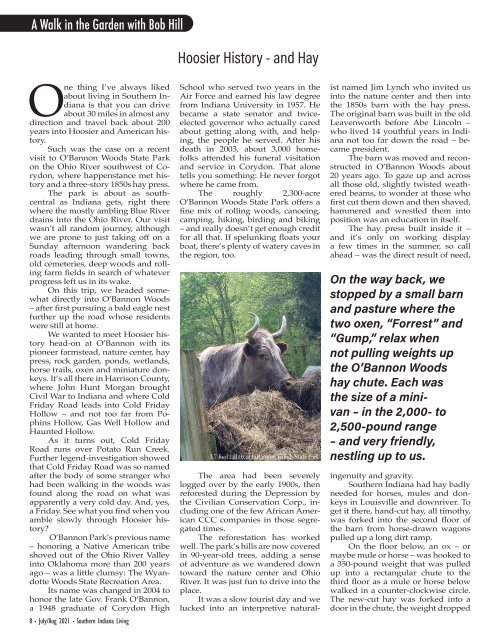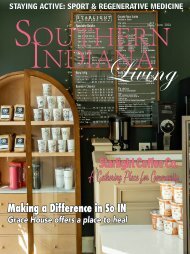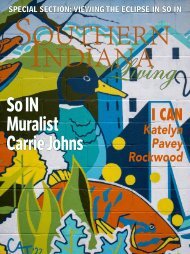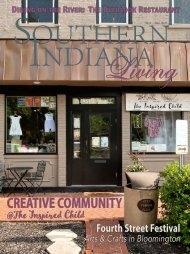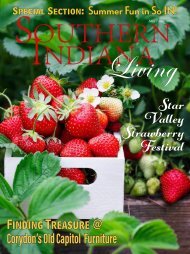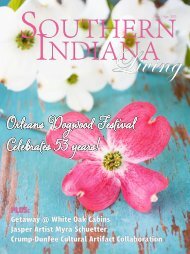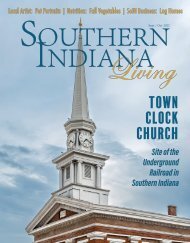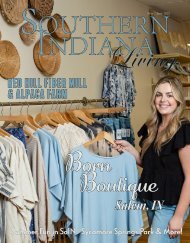Southern Indiana Living . July / August 2021
July / August 2021 Issue of Southern Indiana Living
July / August 2021 Issue of Southern Indiana Living
You also want an ePaper? Increase the reach of your titles
YUMPU automatically turns print PDFs into web optimized ePapers that Google loves.
A Walk in the Garden with Bob Hill<br />
Hoosier History - and Hay<br />
One thing I’ve always liked<br />
about living in <strong>Southern</strong> <strong>Indiana</strong><br />
is that you can drive<br />
about 30 miles in almost any<br />
direction and travel back about 200<br />
years into Hoosier and American history.<br />
Such was the case on a recent<br />
visit to O’Bannon Woods State Park<br />
on the Ohio River southwest of Corydon,<br />
where happenstance met history<br />
and a three-story 1850s hay press.<br />
The park is about as southcentral<br />
as <strong>Indiana</strong> gets, right there<br />
where the mostly ambling Blue River<br />
drains into the Ohio River. Our visit<br />
wasn’t all random journey, although<br />
we are prone to just taking off on a<br />
Sunday afternoon wandering back<br />
roads leading through small towns,<br />
old cemeteries, deep woods and rolling<br />
farm fields in search of whatever<br />
progress left us in its wake.<br />
On this trip, we headed somewhat<br />
directly into O’Bannon Woods<br />
– after first pursuing a bald eagle nest<br />
further up the road whose residents<br />
were still at home.<br />
We wanted to meet Hoosier history<br />
head-on at O’Bannon with its<br />
pioneer farmstead, nature center, hay<br />
press, rock garden, ponds, wetlands,<br />
horse trails, oxen and miniature donkeys.<br />
It’s all there in Harrison County,<br />
where John Hunt Morgan brought<br />
Civil War to <strong>Indiana</strong> and where Cold<br />
Friday Road leads into Cold Friday<br />
Hollow – and not too far from Pophins<br />
Hollow, Gas Well Hollow and<br />
Haunted Hollow.<br />
As it turns out, Cold Friday<br />
Road runs over Potato Run Creek.<br />
Further legend-investigation showed<br />
that Cold Friday Road was so named<br />
after the body of some stranger who<br />
had been walking in the woods was<br />
found along the road on what was<br />
apparently a very cold day. And, yes,<br />
a Friday. See what you find when you<br />
amble slowly through Hoosier history?<br />
O’Bannon Park’s previous name<br />
– honoring a Native American tribe<br />
shoved out of the Ohio River Valley<br />
into Oklahoma more than 200 years<br />
ago – was a little clumsy: The Wyandotte<br />
Woods State Recreation Area.<br />
Its name was changed in 2004 to<br />
honor the late Gov. Frank O’Bannon,<br />
a 1948 graduate of Corydon High<br />
8 • <strong>July</strong>/Aug <strong>2021</strong> • <strong>Southern</strong> <strong>Indiana</strong> <strong>Living</strong><br />
School who served two years in the<br />
Air Force and earned his law degree<br />
from <strong>Indiana</strong> University in 1957. He<br />
became a state senator and twiceelected<br />
governor who actually cared<br />
about getting along with, and helping,<br />
the people he served. After his<br />
death in 2003, about 3,000 homefolks<br />
attended his funeral visitation<br />
and service in Corydon. That alone<br />
tells you something: He never forgot<br />
where he came from.<br />
The roughly 2,300-acre<br />
O’Bannon Woods State Park offers a<br />
fine mix of rolling woods, canoeing,<br />
camping, hiking, birding and biking<br />
– and really doesn’t get enough credit<br />
for all that. If spelunking floats your<br />
boat, there’s plenty of watery caves in<br />
the region, too.<br />
A 7-foot tall Ox at O’Bannon Woods State Park<br />
The area had been severely<br />
logged over by the early 1900s, then<br />
reforested during the Depression by<br />
the Civilian Conservation Corp., including<br />
one of the few African American<br />
CCC companies in those segregated<br />
times.<br />
The reforestation has worked<br />
well. The park’s hills are now covered<br />
in 90-year-old trees, adding a sense<br />
of adventure as we wandered down<br />
toward the nature center and Ohio<br />
River. It was just fun to drive into the<br />
place.<br />
It was a slow tourist day and we<br />
lucked into an interpretive naturalist<br />
named Jim Lynch who invited us<br />
into the nature center and then into<br />
the 1850s barn with the hay press.<br />
The original barn was built in the old<br />
Leavenworth before Abe Lincoln –<br />
who lived 14 youthful years in <strong>Indiana</strong><br />
not too far down the road – became<br />
president.<br />
The barn was moved and reconstructed<br />
in O’Bannon Woods about<br />
20 years ago. To gaze up and across<br />
all those old, slightly twisted weathered<br />
beams, to wonder at those who<br />
first cut them down and then shaved,<br />
hammered and wrestled them into<br />
position was an education in itself.<br />
The hay press built inside it –<br />
and it’s only on working display<br />
a few times in the summer, so call<br />
ahead – was the direct result of need,<br />
On the way back, we<br />
stopped by a small barn<br />
and pasture where the<br />
two oxen, “Forrest” and<br />
“Gump,” relax when<br />
not pulling weights up<br />
the O’Bannon Woods<br />
hay chute. Each was<br />
the size of a minivan<br />
– in the 2,000- to<br />
2,500-pound range<br />
– and very friendly,<br />
nestling up to us.<br />
ingenuity and gravity.<br />
<strong>Southern</strong> <strong>Indiana</strong> had hay badly<br />
needed for horses, mules and donkeys<br />
in Louisville and downriver. To<br />
get it there, hand-cut hay, all timothy,<br />
was forked into the second floor of<br />
the barn from horse-drawn wagons<br />
pulled up a long dirt ramp.<br />
On the floor below, an ox – or<br />
maybe mule or horse – was hooked to<br />
a 350-pound weight that was pulled<br />
up into a rectangular chute to the<br />
third floor as a mule or horse below<br />
walked in a counter-clockwise circle.<br />
The new-cut hay was forked into a<br />
door in the chute, the weight dropped


